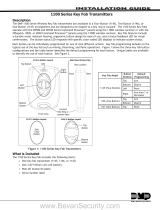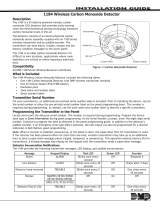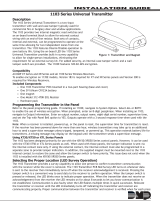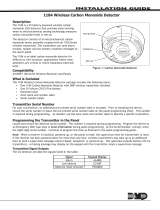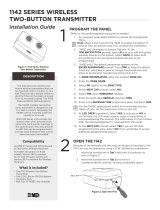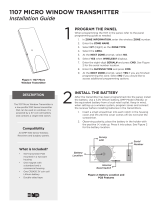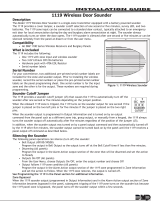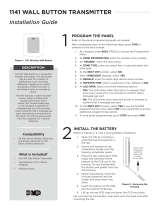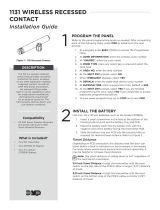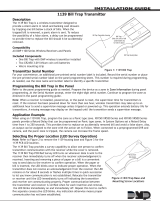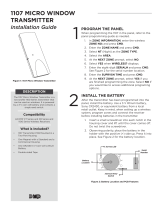Page is loading ...

InstallatIon GuIde
1141 Emergency Wall Button
Description
The 1141 Emergency Wall Button is a one-button wireless emergency
transmitter designed to be wall-mounted. When pressed, an
emergency message is sent to the EM20 Base Unit and a phone call
is placed to the Central Station. The 1141 also provides an LED that
can be programmed to provide visual indication that a panic alarm
has been transmitted. The 1141 operates using the supplied 3.0VDC
lithium batteries.
Compatibility
All DMP 1100 Series Wireless Receivers and Panels
What is Included
The 1141 Emergency Wall Button includes the following:
• One 1141 Emergency Wall Button
• Two 3.0V lithium CR2430 Batteries
• Hardware pack
• Zone name and number label
• Serial number label
Transmitter Serial Number
For your convenience, an additional pre-printed serial number label
is included. Prior to installing the device, record the serial number
or place the pre-printed serial number label on the panel programming sheet. This number is required during
programming. As needed, use the zone name and number label to identify a specic transmitter.
Programming the Transmitter in the Panel
Program the device as a zone in Zone Information during panel programming. At the Serial Number: option, enter
the eight-digit serial number.
At the LED Operation option select YES to turn the LED ON when an emergency signal is transmitted and
acknowledged by the receiver. The LED pulses for ve minutes after the acknowledgement is received from the
wireless receiver. Select NO if you do not want the LED to turn ON when a panic signal is transmitted. The panel
programming default is YES. The LED always provides a single ash to indicate good communication with the 1100
Series receiver when any signal is sent.
Note: When a receiver is installed, powered up, or the panel is reset, the supervision time for transmitters is reset.
If the receiver has been powered down for more than one hour, wireless transmitters may take up to an additional
hour to send a supervision message unless tripped, tampered, or powered up. This operation extends battery life for
transmitters. A missing message may display on the keypad until the transmitter sends a supervision message.
LED Status Operation
The Status LED turns on to acknowledge a button press. See Figure 2.
Mounting the Transmitter
These instructions cover installing the housing on an interior wall.
Figures 3 and 4 show the housing inside and outside views.
1. Install two 1/2” wide strips of double-sided tape in the
indentions on the back of the base housing.
2. Remove the backing from the tape and place the housing in the
desired location on the wall with the LED toward the top. See Figures 3 and 5.
Figure 1: 1141 Emergency Wall Button
Figure 2: Status LED

Digital Monitoring Products 1141 Installation Guide
2
Installing or Replacing the Batteries
Observe polarity when installing the battery. Use only 3.0V lithium batteries, DMP Model CR2430, or the equivalent
battery from a local retail outlet.
Note: When setting up a wireless system, it is recommended to program zones
and connect the receiver before installing batteries in the transmitters.
1. If installed, remove the top housing containing the button and internal
assembly. Insert a at screwdriver into the slot on the bottom of the cover and
gently lift the screwdriver handle toward you while pulling the halves apart.
Repeat with the slot on the top
2. Using your hands, gently separate the top housing from the base.
3. Turn the top housing over and loosen the top PCB snap.
4. Lean the PCB forward and lift the PCB out from the bottom PCB snaps.
5. Remove the old batteries and dispose of properly.
6. Observing polarity, place the 3.0V lithium batteries in the holder and press
into place. See Figure 6 for Battery location.
7. Snap the cover back into place with LED toward the top. See Figure 6.
Caution: Properly dispose of unused batteries. Do not recharge,
disassemble, heat above 212°F (100°C),
or incinerate. Risk of re, explosion, and burns.
Battery Life Expectancy
Typical battery life expectancy for DMP Model 1141 wireless
transmitters is 4 years. DMP wireless equipment uses two-way
communication to extend battery life.
The following situations can reduce battery life expectancy:
• If a receiver is unplugged, or not installed.
Note: Transmitters continue to send supervision messages until a
receiver returns an acknowledgement.
After an hour the transmitter only attempts a supervision
message every 60 minutes.
• When installed in extreme hot or cold environments.
The following situation can extend battery life expectancy:
• Extend transmitter supervision time in panel programming.
Figure 7: Transmitter PCB and Batteries
Figure 4: Screw Mount Figure 5: Installing the Cover
LED
Figure 3: Velcro Mount
1141 Emergency
Wall button
Building Wall
Insert small
screwdriver and
lift to remove
cover.
Do not twist.
Figure 6: Removing the Cover

1141 Installation Guide Digital Monitoring Products
3
FCC Information
This device complies with Part 15 of the FCC Rules. Operation is subject to the following two conditions:
(1) This device may not cause harmful interference, and
(2) this device must accept any interference received, including interference that may cause undesired operation.
The antenna used for this transmitter must be installed to provide a separation distance of at least 20 cm (7.874 in.)
from all persons. It must not be co-located or operated in conjunction with any other antenna or transmitter.
Changes or modications made by the user and not expressly approved by the party responsible for compliance could
void the user’s authority to operate the equipment.
NOTE: This equipment has been tested and found to comply with the limits for a Class B digital device, pursuant
to part 15 of the FCC Rules. These limits are designed to provide reasonable protection against harmful
interference in a residential installation. This equipment generates, uses and can radiate radio frequency
energy and, if not installed and used in accordance with the instructions, may cause harmful interference
to radio communications. However, there is no guarantee that interference will not occur in a particular
installation. If this equipment does cause harmful interference to radio or television reception, which can be
determined by turning the equipment off and on, the user is encouraged to try to correct the interference by
one or more of the following measures:
- Reorient or relocate the receiving antenna.
- Increase the separation between the equipment and receiver.
- Connect the equipment into an outlet on a circuit different from that to which the receiver is connected.
- Consult the dealer or an experienced radio/TV technician for help.
Industry Canada Information
This device complies with Industry Canada Licence-exempt RSS standard(s). Operation is subject to the following
two conditions: (1) this device may not cause interference, and (2) this device must accept any interference,
including interference that may cause undesired operation of the device.
Le présent appareil est conforme aux CNR d’Industrie Canada applicables aux appareils radio exempts de licence.
L’exploitation est autorisée aux deux conditions suivantes : (1) l’appareil ne doit pas produire de brouillage, et (2)
l’utilisateur de l’appareil doit accepter tout brouillage radioélectrique subi, même si le brouillage est susceptible
d’en compromettre le fonctionnement.

LT-1326 1.01 © 2013 Digital Monitoring Products, Inc.
800-641-4282
www.dmp.com
Designed, Engineered and
Assembled in U.S.A.
INTRUSION • FIRE • ACCESS • NETWORKS
2500 North Partnership Boulevard
Springfield, Missouri 65803-8877
13365
Specications
Battery
Life Expectancy 5 years (normal operation)
Type 3.0V lithium CR123A
See Battery Life Expectancy for full details.
Frequency Range: 903-927 MHz
Dimensions
Transmitter Case 3.3” L x 1.6” W x 1.2” H
Color White
Housing Material Flame retardant ABS
Patents
U. S. Patent No. 7,239,236
Listings and Approvals
FCC Part 15 Registration ID CCKPC0155
Industry Canada Registration ID 5251A-PC0155
/
